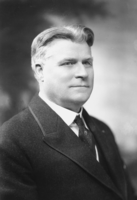 | Back to e-WV
| Back to e-WV
 The West Virginia Encyclopedia
The West Virginia Encyclopedia
 | Back to e-WV
| Back to e-WV
 The West Virginia Encyclopedia
The West Virginia Encyclopedia

Ephraim Franklin Morgan (January 16, 1869-January 15, 1950) was West Virginia’s 16th governor. He was born on a farm near Forksburg, Marion County. He earned a law degree from West Virginia University in 1897 and served with the First West Virginia Regiment during the Spanish-American War. He was city solicitor in Fairmont, 1900–01, and a judge of the Marion County Intermediate Court, 1907–13. Appointed by Governor Henry Hatfield to the Public Service Commission in 1915, Morgan resigned in late 1919 to run as a Republican for governor.
Elected with a plurality of the popular vote in a four-candidate race in 1920, Governor Morgan, like his Democratic predecessor John J. Cornwell, was compelled to dedicate much of his energy to the bitterly divisive West Virginia Mine Wars. Although Morgan displayed personal courtesy to some labor leaders, notably the famous Mary Harris ‘‘Mother’’ Jones, he left little doubt that he believed the governorship enabled him to promote the interests of the state’s coal operators. So loyal were Morgan and most of the West Virginia political elite to the coal industry that a U.S. Senate Committee on Education and Labor declared in June 1921 that the state was in effect ‘‘an industrial autocracy.’’
In the fractious 1920 election, Morgan had defeated Democrat Arthur B. Koontz by less than 60,000 votes. He had also faced a pro-labor non-partisan candidate, Samuel B. Montgomery, and West Virginia’s most prominent Socialist, Matthew S. Holt. The fact that he earned fewer votes than the combined total of these more liberal, pro-labor opponents suggested that Morgan’s anti-union politics, which carried considerable weight with powerful industrial leaders, was not particularly appealing to rank-and-file West Virginia voters. Nonetheless, he persisted. In the mainstream of a nationwide business campaign to portray organized labor as un-American, Morgan annually endorsed America First Day, sponsored by one of the state’s premier anti-union organizations, the American Constitutional Association. A persistent critic of anything he defined as not ‘‘One Hundred Percent American,’’ Morgan was a staunch opponent of the League of Nations. He warned West Virginia schoolteachers that they stood on the front lines in a war against the ‘‘Bolshevistic doctrines that are being disseminated throughout the country.’’
Morgan’s suspicion of organized labor crested in his handling of the tumultuous Mine Wars, which he inherited from Cornwell. Morgan repeatedly petitioned President Warren G. Harding to dispatch federal forces to break the United Mine Workers of America organizing campaign in Mingo and Logan counties in the spring of 1921, which had been marked by escalating labor-management violence. When Harding resisted, Morgan declared martial law in the southern coalfields, relying on the new West Virginia State Police and an anti-union ‘‘vigilance committee’’ of private citizens for enforcement. In the aftermath of the assassination of union hero Sid Hatfield in August 1921, thousands of miners embarked on the famous Miners’ March through Logan County. According to historian Clayton Laurie, Harding at this stage felt compelled to send federal troops, concluding that Morgan and county officials were themselves part of the problem.
This federal intervention halted the march, and ensuing strike-related trials bankrupted the UMWA in southern West Virginia. Morgan served as governor for more than three more years. A major accomplishment of his administration was the building of a new state capitol to replace the fine Victorian capitol which burned two months before he took office. The west wing of the current capitol was completed in March 1925, the last month of Morgan’s term. The Governor’s Mansion was built during the same period, and Morgan moved his family into the house a few days before leaving office.
In 1940, after working for the U.S. Department of Commerce and then reentering the private sector, Morgan ran for the U.S. Senate as a virulent critic of Franklin Roosevelt’s New Deal. Republican power brokers and party voters reviewed the accomplishments of the Morgan years, and apparently concluded they were inadequate. By this time, due partly to the labor law reforms of the New Deal, organized labor had mobilized politically within the Democratic Party and the political calculus in West Virginia had changed. Morgan ran third in the Republican primary, his own party not willing to risk having the former governor on the ticket.
After accepting his position with the Department of Commerce, Morgan spent much of his time in Washington, living the last years of his life there. He died at the Navy hospital in Bethesda, Maryland.
Written by John Hennen
Rice, Otis K. & Stephen W. Brown. West Virginia: A History. Lexington: University Press of Kentucky, 1993.
Morgan, John G. West Virginia Governors, 1863-1980. Charleston: Charleston Newspapers, 1980.
Hennen, John. The Americanization of West Virginia. Lexington: University Press of Kentucky, 1996.
Laurie, Clayton L. The United States Army and the Return to Normalcy in Labor Dispute Interventions: The Case of the West Virginia Coal Mine Wars. West Virginia History, 1991.